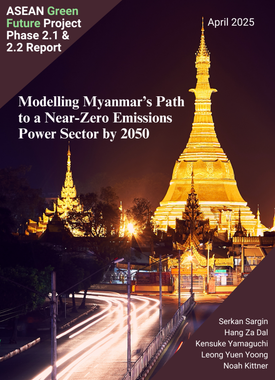
Modelling Myanmar's Path to a Near-Zero Emissions Power Sector by 2050 (Phase 2.1 & 2.2 Report)
Drawing on the ASEAN Green Future’s (AGF) Phase 1 (2021) overview of Myanmar’s greenhouse gas (GHG) emissions and climate actions, and Phase 2’s quantitative modelling of power generation, storage, and transmission pathways in Southeast Asia, the Myanmar report refines the country’s trajectory toward near-zero emissions in its power sector by 2050 using the Stockholm Environment Institute’s Low Emission Analysis Platform (LEAP) and the Next Energy Modelling System for Optimisation (NEMO). It presents results for three scenarios: the Existing Policies Pathway (EPP), which projects demand, supply mix, and emissions under current policies; the Optimised Existing Policies Pathway (OEPP), which improves reliability and cost efficiency but increases dependence on natural gas; and the Optimised More Ambitious Pathway (OMAP), which prioritises renewable energy, energy efficiency, and electrification while limiting fossil fuel and large hydropower use. Findings show that EPP risks severe shortages by 2050 due to aging gas plants, OEPP improves reliability but faces gas supply vulnerabilities, and OMAP—despite higher costs—achieves deep decarbonisation, cutting GHG emissions from 9,925 to 437 thousand MtCO₂ eq, while strengthening long-term energy security through a diversified renewable mix with battery storage.
Downloads and Related Links